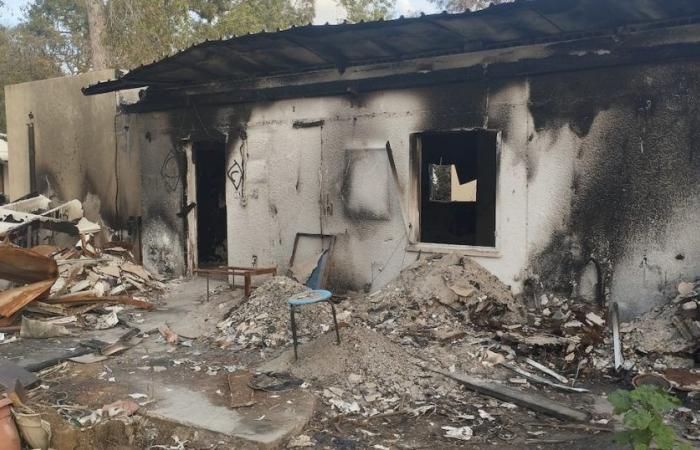
This report is the first in a series produced by Estadão in Israel about the six months since the October 7th attacks and the impact of the war on the country
NIR OZ, ISRAEL – How long does the smell of death last? In kibbutz Nir Oz, in the south of Israelthe marks of the horror perpetrated by the terrorist group Hamas, us October 7th attack, still affect the five senses, months after the tragedy. It is difficult to pass through the cafeteria used as a makeshift morgue due to the odors still present.
Kibbutz houses, some incinerated, others riddled with bullets, will have to be demolished. In one of them, everything turned to ash and twisted iron. In another, there is still blood on the floor from people who tried to protect themselves from the terrorists’ fury. It is possible to hear Israeli artillery shots in the Gaza Strip, 1.5 km away. On the horizon, half-destroyed buildings in Khan Younis, one of the Army’s targets, are visible to the naked eye.
During the report’s visit, in early March, Nir Oz was still isolated by order of the Israeli government. The kibbutz, however, serves as a metaphor for how Israel experiences October 7th. That Saturday didn’t end and many relive those 24 hours, day after day.
The family of Michel Nysembaum, the only Brazilian hostage held by Hamas, says that this is exactly their reality. “I live the 7th, again and again, and I can’t go back to my normal life”, says Ayala Harel, the Brazilian’s niece.
Families in the crosshairs of an attack
Hamas has been attacking southern Israel with rockets and missiles since 2001. As a result, an entire infrastructure was prepared in the region to prevent a very specific type of attack.
On the road that connects Tel-Aviv to southern Israel, for example, there are several shelters against these missiles. They are small concrete buildings, without doors, for civilians to protect themselves until the projectiles are intercepted. The kibbutzim houses in the region have safe rooms, with reinforced doors and windows, to resist a rocket that escapes from the Iron Dome anti-aircraft system, responsible for eliminating the dangers coming from Gaza.
On October 7, however, none of this was enough to prevent the massacre of 1,200 people. Those who locked themselves in the safe room saw Hamas incinerate the house. Those who sought an anti-aircraft shelter were targeted by gunfire and grenades. And anyone who was in an open area became an easy target.
The road of death
According to the report of his sister, Mary Shohat, and his niece, Michel Nysembaum, a former fighter in the Israeli Air Force, where he emigrated more than 40 years ago, was alerted by his daughter on the morning of the 7th that there was a terrorist attack ongoing. His son-in-law gave him a similar account, although the exact scale of what was happening was not known.
Even so, the father of two women and grandfather of six children decided to pick up one of them, aged 4, with his son-in-law, who served at the Re’im base, about 10 km from the Gaza Strip.
Nysembaum then took the car, a gun and left Sderot, where he lived, heading south and entered highway 232. The road, in the days following the attack, would become known as the ‘highway of death’. He drove for a few minutes, while Hamas men in pickup trucks equipped with rifles attacked cars and pedestrians, fired at random and prepared ambushes.
Nysenbaum attempted to contact police at 7:02 am. Then he stopped answering the phone. Minutes later, his daughter was only able to speak to men who shouted ‘Hamas’ and words in Arabic.
Police located his car and a laptop in the days following the attack and to this day there are no details about his condition. The medicines sent by the Red Cross, according to the association that represents the hostages, never reached those who needed them.
“We are in the hands of Hamas, they do what they want with us. My brother has diabetes and Chron’s disease. I don’t know if he will survive without the medicine”, says Mary Shohat. Despite this, she maintains hope. “I’m going to give him sweets that he likes and have saved for the reunion.”
Massacre in the open field
Road 232 was also the scene of the cold-blooded execution of some of the victims of the Nova electronic music festival and the drama of another Brazilian, Rafaela Treitsman from São Paulo. The girl has lived in Israel since 2021 and just a few months earlier she had met her boyfriend, Hanani Glazer, an electronic music fan.
On the weekend of the 7th, they both decided to go to Nova, which would be held a few kilometers from the Gaza Strip. Just before 7am, the couple and a Brazilian friend, Rafael Zimerman, began hearing missiles.
Until then, most young people just followed the Iron Dome protocol: look for shelter, and wait. No one imagined that a land invasion would occur. When it became clear that there were terrorists in Israel, the situation became more complicated.
Rafa, his boyfriend and a friend looked for a ride to a nearby shelter, where they stayed alone for a while. Over the hours, more and more civilians sought refuge there. There, a 6 m² concrete block, with capacity for 20 people, housed more than 40. Outside, Hamas men were shooting and throwing grenades and gas bombs.
Rafaela was lucky to have been one of the first to arrive at the shelter. The very capacity of the place, combined with Hanani’s protection, prevented the shots from targeting her. Her boyfriend was with her the entire time, protecting and calming her. After hours of siege, they managed to be rescued by the Army. Hanani wasn’t as lucky as his girlfriend and friend. He was shot by one of the terrorists’ shots.
Today, still traumatized, the young woman is trying to rebuild her life. “I have difficulties with everything. I turned into a zombie the first month after the attack. I have dreams, nightmares, fears. The memories are very heavy.”, she says. “But there is a post and that is my biggest message. I always try to stay positive and Hanani is my light.”
Echoes of the Holocaust
Argentine-Israeli Silvia Cunio has the sad, empty look of a mother who doesn’t know the whereabouts of her children. What’s more, she knows firsthand what the family went through at the hands of Hamas, in a trauma that evokes the Jewish community’s worst memories. On October 7, Hamas terrorists invaded kibbutz Nir Oz, and attacked the homes of his three children. Eitan, David and Ariel. The last two are still in the hands of Hamas.
Eitan survived the attack, but his story is perhaps one of the cruelest in Nir Oz, where around a quarter of the population of 400 people died or became hostage to terrorists.
According to his mother’s account, on the day of the attack, the electrician, his wife and their two daughters locked themselves in the safe room of the kibbutz house to protect themselves from the terrorists. The rooms, like most in the region, were made to withstand a missile or rocket. The Hamas men then decided to set fire to the place. With people inside.
The hours passed, the temperature continued and the room heated up. Everyone fainted. When he regained consciousness, Eitan tried to escape. “I wouldn’t die like that,” he would later tell his mother.
But the heat had melted the door handle. The windows were also locked. The electrician then made the decision that saved his life and that of his family: he removed the air conditioning from the wall, which gave him an opening to breathe.
Hours later, they would be rescued. Other houses in the kibbutz were also set on fire with people inside.
The report visited the places destroyed by the fire. All the furniture turned to ash and twisted iron. All the walls were blackened by the flame. Many were doomed.
“Now we are waiting for my children to return alive”, says Silvia. “Hope is the last thing to die.”
Amphibious assault
Zikim, north of the Gaza Strip, was one of Hamas’ first targets on the 7th. Frequented by young people that early autumn, it is a simple beach, with a long strip of sand, bathed by the Mediterranean Sea. It has a small structure of bathrooms and a modest bar that serves drinks and some snacks to visitors, most of whom live in kibbutzim and surrounding towns.
According to Moshiko Moskovitz, a paramedic and Army reservist on the Zikim kibbutz, that Saturday was a public holiday and some young people had camped on the beach. It was dawn when speedboats with at least ten Hamas men invaded the beach.
Armed, they began to shoot. Some young people tried to hide in the bathrooms and bar. The marks are still visible at the site. Many shots, some of large caliber, indicate that the victims had little or no chance of defense. In the restaurant, the drinks refrigerators are half-destroyed and abandoned, and the scene is dismal.
Kilometers away is one of Israel’s main power plants. The terrorists tried to reach the location, but were stopped. The beach attack, quite sophisticated in military terms, as well as its objectives, also indicate that the magnitude of Hamas’ plan was unprecedented in Israel’s history.
“The terrorists who escaped tried to invade the kibbutz and an Army training base,” he says. “But the kibbutz defense group and the base managed to prevent an invasion.”
According to the paramedic, if the terrorists had managed to take over the base and the plant, the damage would have been even greater.
* The reporter traveled to Israel at the invitation of the NGO StandWithUs Brasil
Tags: day Trauma smell death places attacked Hamas southern Israel
--




